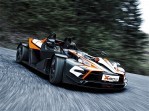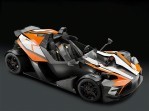Body style: Convertible (spider/spyder, cabrio/cabriolet, drop/open/soft top)
Segment: Roadster & Convertible
Production years: 2011, 2012, 2013, 2014, 2015, 2016, 2017, 2018, 2019, 2020, 2021, 2022, 2023, 2024
 21 Photos
21 PhotosThe Austrian car manufacturer KTM introduced in 2011 a refreshed version of the original 2008 X-Bow, adding more power and a few tweaks to the car's look and interior.
Some people wanted to race weekend after weekend, and sometimes, a regular supercar just couldn't cut it. It was too expensive to buy, run, and maintain. So, they looked for a more affordable, logical solution. Then, the Austrian motorcycle manufacturer KTM cut a deal with Audi to buy engines and transmissions from them and talked to the American race-car engineering company Dallara to create a carbon-fiber chassis, and that was the beginning of a beautiful friendship. But the 2008 version, with its 240 PS (237 hp), couldn't keep up with the improved versions of Italian supercars. As a result, in 2011, KTM brought the improved X-Bow R.
The unique-looking X-Bow R featured a front fascia with a bow-shaped carbon fiber element that took center stage. It didn't feature a bumper. Instead, it had a lower horizontal slat connected to the bodywork's upper elements via two oblique connecting parts. As a result, the push-rod suspension system was exposed to elements and could be accessed easily. To be road-legal, the car had to have headlights, and these were mounted above a front horizontal panel in individual clusters.
From its profile, the roadster didn't have a windshield or doors. Customers had to hop in above the side elements that formed the protective tub of the vehicle. Still, they had to remove the steering wheel to sit in the driver's seat. Behind the cabin, the tall safety arches and the hunch over the engine compartment resembled more of a mid-engined race car than anything else. Finally, at the back, the automaker hung the round taillights under the panels mounted in the back while the dual exhausts peaked through a metallic plate between the wheels.
The cockpit was just an extension of the race-ready roadster. It featured a digital display for the instrument panel mounted atop the center beam that crossed the car from front to back. Drivers had to deal with the multiple buttons on the steering wheel to activate the blinkers or the lights. In addition, they could alter the engine settings during a race without getting their hands off the wheel. The short stick for the manual gearbox was mounted on the center beam close to the instrument LCD.
But the most significant upgrades happened under the roadster's skin. With proper tuning and improvement, which included a larger turbocharger, the 2.0-liter TFSI engine supplied by Audi reached 300 PS (297 hp), 60 PS more (58 hp) than the 2008 model. In addition, the automaker modified the suspension and installed the engine lower in the bay, leading to a lower center of gravity. As a result, the car's performance was improved over its non-facelifted sibling, leading to quicker lap times.
KTM X-Bow R 2011, 2012, 2013, 2014, 2015, 2016, 2017, 2018, 2019, 2020, 2021, 2022, 2023, 2024
- 2.0 6MT (300 HP)
KTM X-Bow R
2.0 6MT (300 HP)
ENGINE SPECS - 2.0 6MT (300 HP) | |
|---|---|
| Cylinders: | L4 |
| Displacement: | 1984 cm3 |
| Power: | 220.7 KW @ 6300 RPM 300 HP @ 6300 RPM 296 BHP @ 6300 RPM |
| Torque: | 295 lb-ft @ 3300 RPM 400 Nm @ 3300 RPM |
| Fuel System: | Turbocharged Direct Injection |
| Fuel: | Gasoline |
PERFORMANCE SPECS | |
|---|---|
| Top Speed: | 144 mph (232 km/h) |
| Acceleration 0-62 Mph (0-100 kph): | 3.9 s |
TRANSMISSION SPECS | |
|---|---|
| Drive Type: | Rear Wheel Drive |
| Gearbox: | 6-speed manual |
BRAKES SPECS | |
|---|---|
| Front: | Ventilated Discs |
| Rear: | Ventilated Discs |
TIRES SPECS | |
|---|---|
| Tire Size: | 205/40 R17 || 255/35 R18 |
DIMENSIONS | |
|---|---|
| Length: | 147.2 in (3739 mm) |
| Width: | 75.4 in (1915 mm) |
| Height: | 47.3 in (1201 mm) |
| Front/rear Track: | 65.8/64 in (1,671/1,626 mm) |
| Wheelbase: | 95.7 in (2431 mm) |
WEIGHT SPECS | |
|---|---|
| Unladen Weight: | 1742 lbs (790 kg) |
FUEL ECONOMY (NEDC) | |
|---|---|
| Combined: | 28.3 mpg US (8.3 L/100Km) |
| CO2 Emissions: | 189 g/km |




















